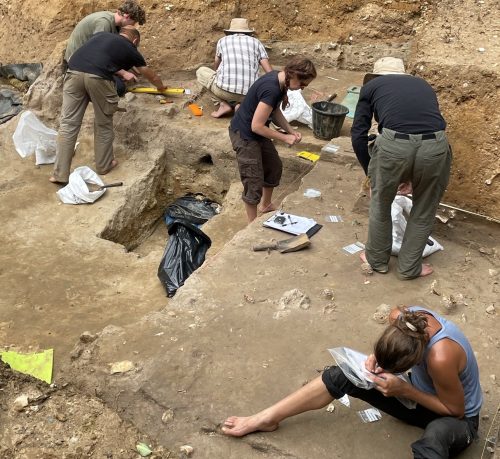As 2022 begins we take the opportunity to look back on the year just ended and to look forward to the year ahead
For the Pathways to Ancient Britain project 2021 saw a resumption of fieldwork, publication of several papers by PAB researchers and a range of engagement activities. Here are some of the highlights from 2021 and a quick look forward to plans for 2022.
The well-established excavations at East Farm, Barnham were put on hold in 2020, but we were able to return to the site in 2021 and complete a scaled-down season of fieldwork. This focused on sampling and sieving sediments from the fauna-bearing deposits in Area III, completing a borehole programme and exploring further the evidence of fire at the site. Later in the year, PAB researcher Dr Rob Davis led excavations at a less well-known Breckland site, Devereux’s Pit, Icklingham. An enlarged archaeological area yielded a number of Lower Palaeolithic artefacts and over 20 boreholes were drilled to investigate the stratigraphy. The identification of sediments containing shells and bone fragments offers the potential for palaeoenvironmental reconstruction and amino acid dating, analysis is now underway.

Results from the Breckland Palaeolithic Project were published in two papers in 2021, looking at the geology and archaeology of the Bytham River. The first to appear (Davis et al., 2021) reassessed the old collections from a number of sites within the terrace deposits of the Bytham River and identified important patterns in the Palaeolithic record. The second paper (Lewis et al., 2021) established a revised model for the terrace stratigraphy of the Bytham River and through the application of Electron Spin Resonance dating methods, provided a chronological framework for these deposits, supporting the pre-Anglian age for these sediments and the Palaeolithic archaeology contained therein.
Although the focus of fieldwork has shifted from Happisburgh to the Breckland over the last few years, the Norfolk coastline continues to be an important research area for the PAB project. In 2021 the latest paper on Palaeolithic archaeology at Happisburgh (Bynoe et al., 2021 [OA]) reported on the substantial collection of finds from the beach and foreshore that has been amassed by collectors regularly visiting and ‘fieldwalking’ the beach and carefully recording the location of their finds using GPS. A large number of lithic artefacts and faunal remains were studied for the paper and spatial patterns could be identified relating to both known archaeological sites at Happisburgh and also suggesting previously unknown locations that may be releasing artefacts and fauna onto the beach.
Other papers to appear in 2021 included Rob Davis’s analysis of the Test valley’s Palaeolithic record (Davis et al., 2021), and a review of the early Acheulean in Britain (Ashton and Davis, 2021), developing a “Cultural Mosaic Model” to explain the differences in lithic assemblages in Britain and beyond.

Public engagement activities during 2021 provided further opportunities for PAB researchers to share their research with a range of audiences. PAB research associate Dr Claire Harris led a number of engagement activities. The Deep History Detectives weekend in July comprised a knapping workshop, training in artefact identification and beach walks to explore the geological succession and archaeological sites along the Happisburgh coastline. A collaborative project, funded by Queen Mary University of London, with members of the education team from Norfolk Museum Service enabled the development of a teaching resource for school groups visiting Cromer Museum. In November the PAB project partnered with the Prehistoric Society to run an online panel discussion “Are genes deep history?” as a contribution to the 2021 Being Human Festival of the Arts and Humanities.
So, what’s in store in 2022? Hopefully it will be possible to continue the field excavations at Barnham and Devereux’s Pit. In addition, a small-scale excavation is planned at Beeches Pit, West Stow, to investigate the archaeological content of the lower part of the sequence. Work at Happisburgh is continuing with more beach finds to analyse and write up as well as results from Site 1 to progress towards publication. Another paper from the Breckland Palaeolithic Project, this one reporting the results from the Little Ouse terraces, including the important Palaeolithic sites at Santon Downham and Barnham Heath is also in the works. All in all, it looks like another busy year ahead!
